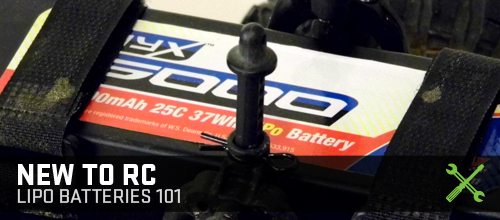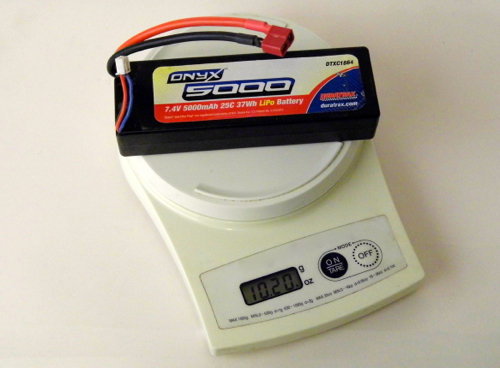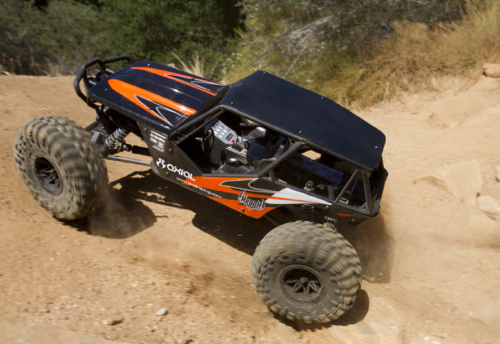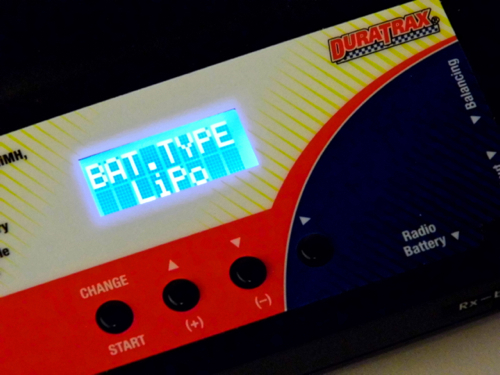Posted: 2/27/13

Batteries are nothing new. These simple devices have actually been around for hundreds of years, and they are found in items we use everyday—cell phones, laptops, TV remotes, etc. So, what’s the big deal? The big deal is the technology commonly used in RC has shifted. Specifically, LiPo (lithium polymer) has replaced NiMH (Nickel Metal Hydride) as the preferred type of battery chemistry. And with anything new comes hype—good and bad. While many people may be intimidated by LiPo batteries, to get absolute maximum performance out of your Axial Racing vehicle, you should seriously consider going LiPo. Here is what you need to know.
LIPO 101 QUICK GUIDE & ESSENTIAL SAFETY RULES
> Use a LiPo battery with a 25C rating or higher
> Only use a LiPo-compatible charger in the LiPo mode
> Use the balance mode
> Do not leave a charging pack unattended
> Always charge in a fire resistant battery sack
> Do NOT over discharge a LiPo pack and make sure your speed control is properly programmed
> Store LiPo packs 50- to 60% charged
SAFE OR NOT?
Anything improperly used can be dangerous. A hammer lying on a bench can’t do harm, but if used incorrectly and you may be getting X-rays. Much of the concern with LiPo batteries started and has stuck around because of misuse taking place when LiPo cells first started to get used in RC. Improper charging, use and storage led to failures and this led to a very negative view of LiPo batteries. Now that LiPo specific chargers are readily available and we know how to care for these cells, LiPo batteries are perfectly safe if used properly. Again, the more factual view of LiPos is that, if used properly, they are, indeed, perfectly safe and no more dangerous any other type of battery.

BENEFITS OF LIPO
LiPo cells offer many advantages over older cell chemistries such as NiMH. Most notably, a LiPo cell with the same capacity and approximate voltage will be significantly lighter and smaller than its NiMH counterpart. Along the same lines, if you replace a NiMH pack with a LiPo pack of the same approximate size and weight, you will have a battery with significantly more capacity.
Even better and a little more technical, the discharge curve of a LiPo is much better suited for RC use. The power delivered from a LiPo stays more constant as it’s discharged. In contrast, a NiMH gets noticeably weaker (the voltage decreases) as it discharges. If you install a NiMH pack in an Axial Wraith, even if the runtime is in the double digits, the acceleration and top speed will be noticeably lower halfway through your run compared to when you first started your run. A LiPo installed in the same Wraith will deliver essentially the same performance through the entire run. Who would want a full-size vehicle that got slower as you got lower on gas?
LiPo cells also have lower internal resistance compared to NiMH. They deliver more power than their NiMH counterparts. This means that a 2-cell LiPo battery (known as a 2S pack since the pack is made of two cells wires in series) with a total voltage of 7.4 is more powerful than a typical 6-cell NiMH pack, even though the NiMH has a similar 7.2 voltage. To get comparable power to a 7.4V 2-cell LiPo, a 7-cell 8.4V pack is actually needed.
LiPo cells don’t lose voltage nearly as fast during storage. While you shouldn’t store a LiPo fully charged (more on that below), you can charge a LiPo in the morning and use it hours later with no depreciation in power. A NiMH only delivers its peak performance if used immediately after it’s charged.
Higher charge rates are possible with LiPo cells, which means they can be charged faster than NiMH cells. Most NiMH packs are best charged at a rate of 5 amps. When used with a balance charger (Note: always use a balance charger), LiPo cells can be charged at high amp rates, which significantly reduces downtime.
There’s more. Unlike NiMH cells, which are best used only once per day, LiPo cells can be used as many times as you like.
Even more. LiPo cells have no “memory.” LiPo packs do not have to fully discharged before charging. Hypothetically, if you routinely use a NiMH pack for five minutes and then try to use it for ten minutes, you will notice it falls flat at about five minutes. This is because the chemistry has what is called memory. It gets conditioned with each use.

PROPER LIPO USE
Proper use of a LiPo starts with the proper purchase. You get what you pay for. With a Duratrax Onyx 4000mAh LiPo costing less than $50 at most locations and only $40 at many others, there is no reason to risk your hard earned money on a cheap pack. The choice is yours, but you get what you pay for. An individual LiPo cell is rated at 3.7 volts. When wired in series, the voltage increases by 3.7V with each cell added. So, a 2S pack is 7.4V and a 3S pack is 11.1V. Cells or groups of cells wired in parallel increase capacity. Two 1000mAh cells wired in parallel (2P) will have a capacity of 2000mAh.

Charge Mode
The second step in proper LiPo use is to use a LiPo-specific charger. Only use a charger that uses the CC/CV (constant current/constant voltage) method. In brief, this means the charger maintains a constant current (amps) until a specific voltage is reached. At that point, the charger adjusts the current to maintain that voltage until the pack is fully charged. Since most chargers charge many types of batteries, it is essential you make absolutely certain you are using the LiPo mode. While it’s important to note that LiPo packs do not actually explode. They can, however, burst into flames and for that reason, it is a best practice to use a battery sack (made out of flame resistant material) and to never leave a charging pack unattended.
Balance Charging
LiPo cells usually have an additional plug that allows the charger to monitor each cell individually and make sure a cell isn’t overcharged. As the name implies, balance charging will make sure each cell is equally charged. This increases performance, increases the life of the pack and makes for safer charging.
Charge Rate
When setting up your charger, you will most likely need to select the charge rate. The charge rate is based on the capacity of the pack. For example, charging a 5000mAh Duratrax Onyx pack at 1C means the charger will charge it at a 5-amp rate. 2C is 10 amps and cuts the charge time in half. Always follow the recommendation of the battery manufacturer. If you’re not sure, charge at 1C.
Use
Using a LiPo pack is essentially no different than any other type of battery—with one big exception. A low voltage cut-off is absolutely essential to prevent the pack from being over discharged. Over discharging is one of the most common ways LiPo packs are damaged. Most modern speed controls come with low voltage cut-off built-in. Axial Racing ready-to-run vehicles come with the voltage cut-off set for LiPo use (Auto-LiPo mode). The general recommendation for the lowest voltage a LiPo cell should be allowed to get to is 3.3V. The “normal” voltage of a LiPo cell is 3.7V (in comparison a NiMH is 1.2V per cell). If you have access to a temp gun, your LiPo pack should never exceed 130 degrees F.
Storage
It is important to know temperature changes can impact the voltage of battery packs. If a LiPo is left in a hot car, the voltage will rise and it is highly likely the pack will be ruined. Extremely cold conditions can do just the opposite. The simple solution is to store your batteries in a cool, dry place and out of prolonged direct sunlight. In addition to storing your LiPo packs in an appropriate location, it is important to install them partially charged. Don’t store your LiPo packs plugged in (even when the speed control is turned off there can be a current draw that will slowly drain the pack) and do not store packs in the vehicle. Store packs partially charged. 50- to 60% charged is perfect. Do not store packs fully charged.